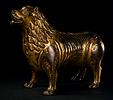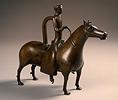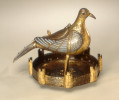Tour: Medieval Metalwork and Enamels
| Overview | Start Tour | ||
 |
 |
 |
| 1 | 2 | 3 |
 |
 |
 |
| 4 | 5 | 6 |
| » | next | |||
| « | back to decorative arts | |||
Overview
Each of the object types on this tour originally served sacred purposes. The Chalice of Abbot Suger (1), the Spanish ciborium (7), and the dove-shaped pyx (6) were each associated with the celebration of the liturgy; the reliquary châsse (3) formed a miniature "tomb" for the relic of a saint; the morse (8) was a fastener for ecclesiastical garb; and the crucifix (2) served as an object of devotion that could be inserted into a staff for processional use. The two aquamanile (4, 5), or pitchers in animal or human forms, were used for either liturgical or secular handwashing.
Captions
